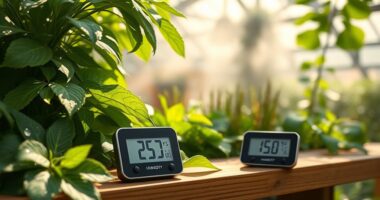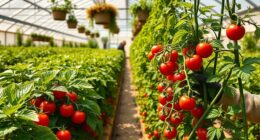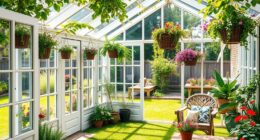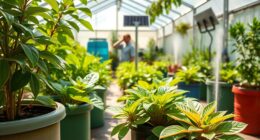Greenhouse and outdoor gardening each have unique benefits. With a greenhouse, you can control temperature, humidity, and light, allowing for year-round plant growth and better pest management. Outdoor gardening relies on natural conditions and usually costs less initially, but it’s more weather-dependent and exposed to pests. Your choice depends on your goals, budget, and climate. Keep exploring to discover which method suits your gardening dreams best.
Key Takeaways
- Greenhouses offer controlled environments for year-round, diverse plant cultivation, unlike outdoor gardens which depend on natural weather conditions.
- Indoor greenhouses require higher initial investment and maintenance, whereas outdoor gardening generally involves lower upfront costs.
- Pest management is more straightforward in greenhouses due to containment, while outdoor gardens face broader pest exposure.
- Greenhouses allow precise regulation of temperature, humidity, and light, extending growing seasons and boosting productivity.
- Outdoor gardens benefit from natural ecosystems and typically have a more sustainable, eco-friendly footprint.
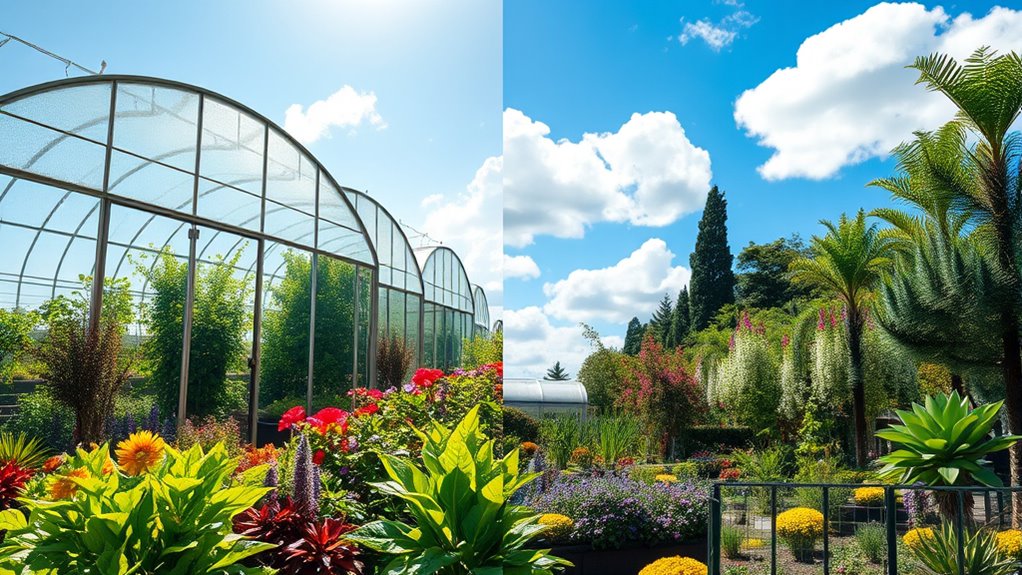
When choosing between greenhouse and outdoor gardening, understanding the key differences can help you make the best decision for your plants and environment. One of the most noteworthy distinctions lies in climate control. In a greenhouse, you have the ability to regulate temperature, humidity, and light levels, creating a stable environment that supports plant growth year-round. This control minimizes the risks posed by unpredictable weather patterns, frost, or excessive heat. You can extend your growing season and cultivate a wider variety of plants, regardless of external conditions. Conversely, outdoor gardening relies on natural climate conditions, making it more susceptible to weather fluctuations. While this can limit your growing window, it also means you’re working with the natural environment, which some gardeners find more satisfying and sustainable.
Another important aspect is the synthetic environment within a greenhouse, which can be carefully controlled to optimize plant health and productivity. Greenhouses often require a dedicated space and infrastructure, which can influence your overall gardening budget. Pest management also varies considerably between the two methods. Greenhouses offer a more contained space, making it easier to monitor and control pests. You can implement targeted measures such as screens, traps, or organic treatments without worrying about pests migrating from the surrounding environment. The enclosed setting helps reduce pesticide use and can keep your plants healthier. However, pests can still find their way inside, so regular inspection remains essential. Outdoor gardens, on the other hand, are exposed to a broader range of pests and diseases carried by insects, birds, or neighboring plants. Managing these threats often requires more vigilance and a combination of natural predators, barriers, or organic treatments. While outdoor gardens may be more vulnerable, they also benefit from the natural balance of ecosystems, which can sometimes keep pest populations in check without intervention.
In addition to climate control and pest management, your decision may hinge on other factors like space, cost, and personal preference. Greenhouses often demand a higher initial investment and ongoing maintenance but provide a controlled environment that can boost productivity and variety. Outdoor gardening generally requires less upfront cost and aligns more closely with traditional gardening practices, but it demands adaptability to weather and pests. Proper planning and cost considerations can help ensure your gardening setup is sustainable and enjoyable. Additionally, selecting the right garden layout can greatly influence your success, whether in a greenhouse or outdoor space. Moreover, advances in home security systems have made it easier to protect outdoor gardens from theft or vandalism, especially in larger properties. Incorporating climate monitoring technologies can further optimize your gardening efforts by providing real-time data on environmental conditions. Ultimately, your choice depends on your goals, resources, and the plants you wish to grow. If you’re seeking a controlled environment with fewer pest issues and extended growing seasons, a greenhouse might be the better option. If you enjoy working with nature and prefer a more natural approach, outdoor gardening could suit you better. Understanding these differences ensures you pick the method that aligns with your gardening ambitions and environment.
Frequently Asked Questions
How Does Pest Control Differ Between Greenhouses and Outdoor Gardens?
In pest control, you’ll find that greenhouses allow for more targeted methods. You can use biological control, releasing beneficial insects to manage pests effectively. Pest barriers, like screens, keep unwanted bugs out. Outdoor gardens rely more on natural predators and organic sprays, which can be less predictable due to environmental factors. Overall, greenhouses give you more control, making pest management more precise and manageable.
What Are the Initial Costs Associated With Setting up Each Gardening Method?
When comparing the costs and startup expenses of each gardening method, you’ll find greenhouses generally require a higher initial investment due to structure, heating, and lighting costs. Outdoor gardens tend to have lower startup expenses, mainly for soil preparation, seeds, and basic tools. The cost comparison shows greenhouses offer year-round control but at a higher price, while outdoor gardens are more budget-friendly but depend on weather conditions for success.
How Do Weather Fluctuations Impact Crop Growth Differently in Greenhouses Versus Outdoors?
Imagine your crops as sailors steering unpredictable seas. In greenhouses, you’re the steady lighthouse, providing climate resilience and temperature stability, shielding plants from weather fluctuations. Outdoors, they face the storm’s full force, risking damage from temperature swings and unpredictable climate changes. Greenhouses help maintain consistent growth conditions, while outdoor crops are more vulnerable to weather shifts, which can hinder development and yield. You control the environment better indoors, ensuring steady crop growth.
Which Gardening Method Offers Better Year-Round Growing Potential?
You’ll find that greenhouses offer better year-round growing potential through season extension, allowing you to grow crops even in harsh weather. This method also broadens your crop variety because the controlled environment minimizes weather-related risks. Outdoor gardening relies on natural seasons, limiting growth times and crop options. By choosing a greenhouse, you maximize your growing season and diversify your crops, ensuring a steady supply regardless of external weather fluctuations.
What Are the Environmental Impacts of Greenhouse Versus Outdoor Gardening?
You might wonder which gardening method impacts the environment more. Greenhouses often require more water usage and can cause soil disturbance from construction and maintenance. Outdoor gardening generally uses less water but may involve more land disturbance and runoff. Both methods affect local ecosystems differently; greenhouses concentrate resources, while outdoor gardens integrate more naturally. Understanding these impacts helps you make eco-friendly choices for sustainable gardening.
Conclusion
Whether you choose greenhouse or outdoor gardening, understanding the key differences helps you make informed decisions. Both options offer unique benefits, both require your commitment, both demand your care. By weighing the advantages of each, you can create a gardening experience that suits your environment, your plants, and your goals. Ultimately, your success depends on your knowledge, your effort, and your passion—whether indoors or out, your garden is a reflection of your dedication.



